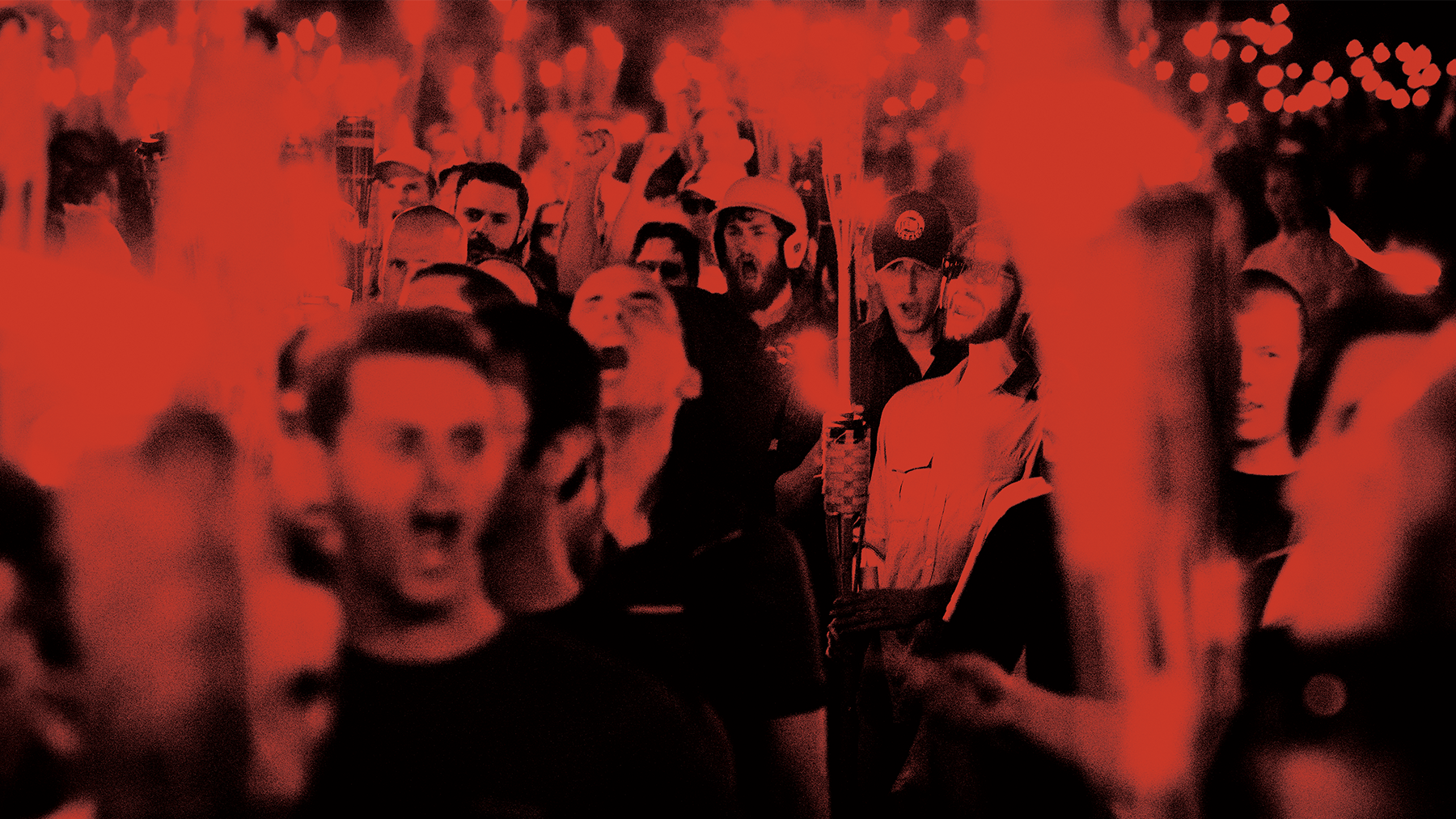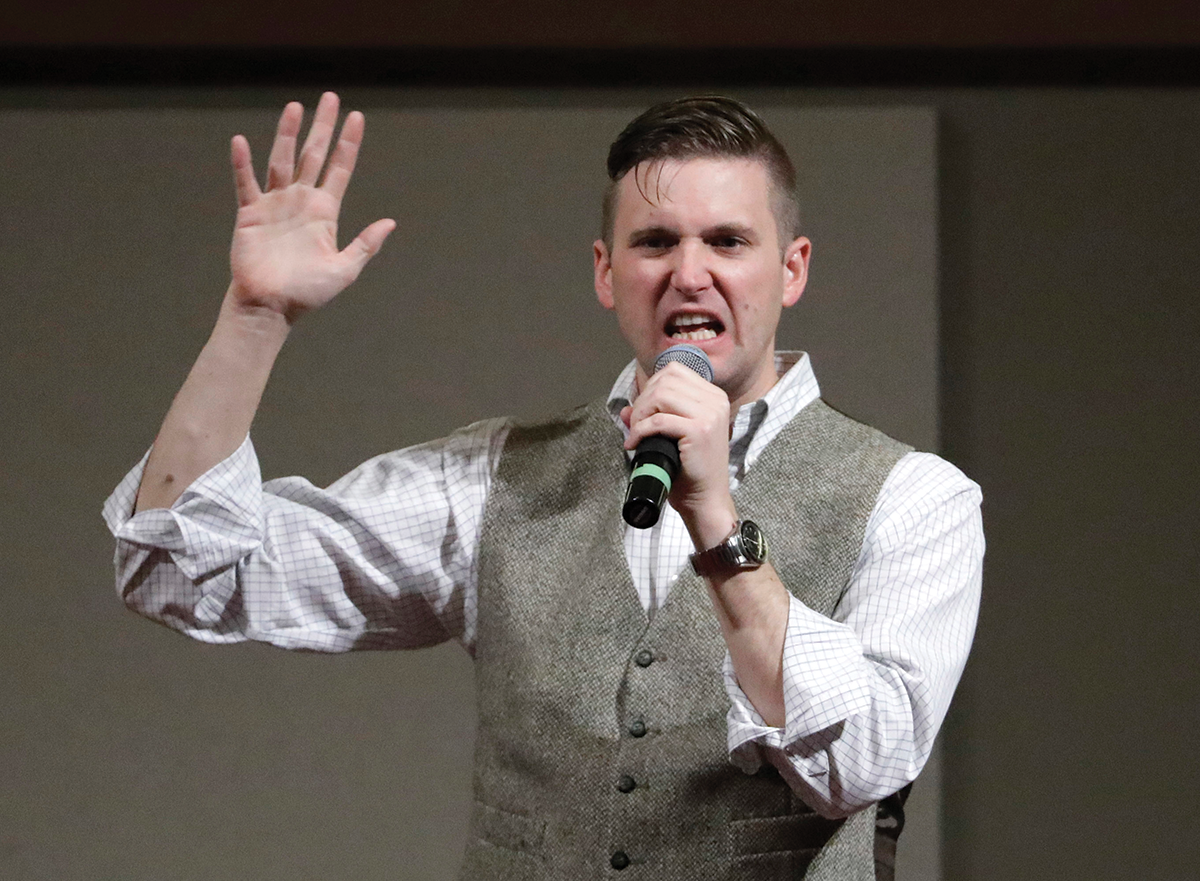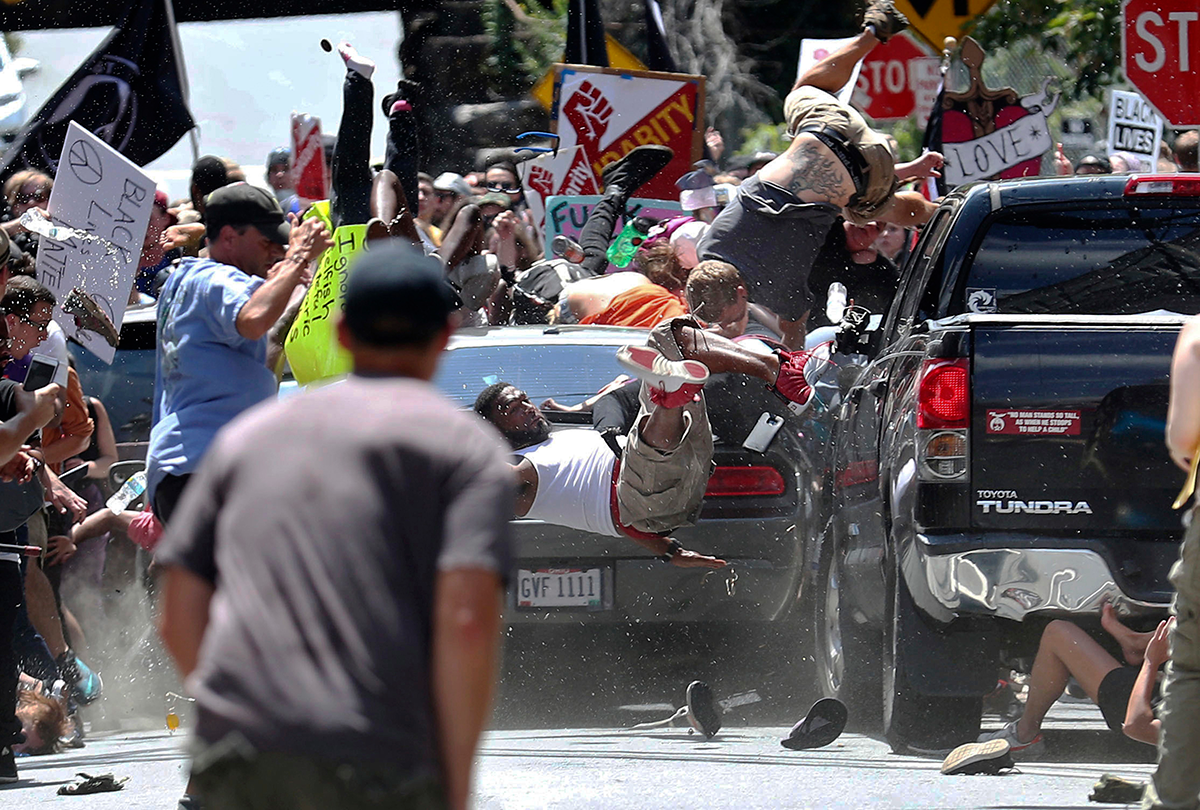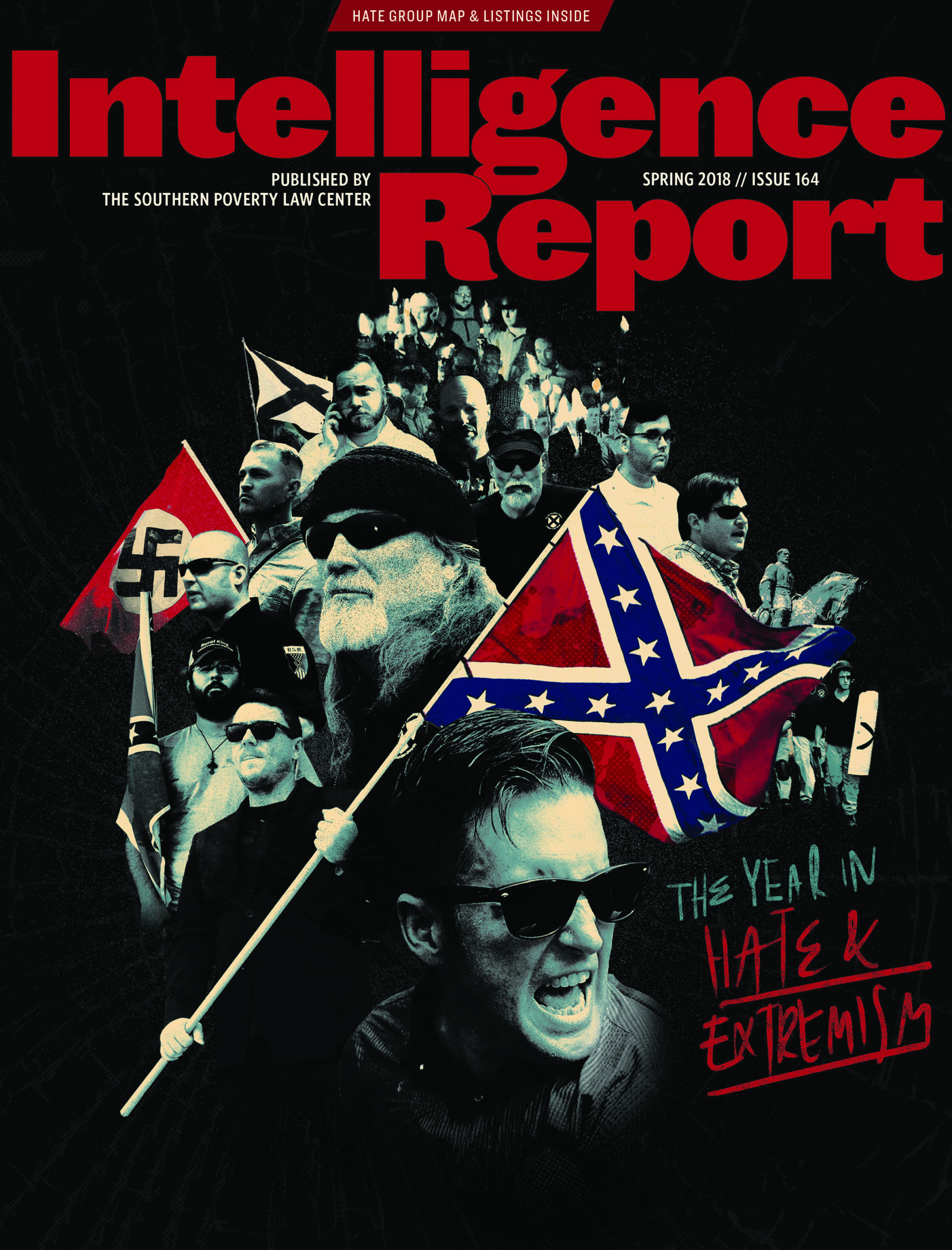A fractured but energized movement tried to pull itself together — but ended up exposing even deeper rifts.

On Friday, August 11, Charlottesville, Virginia, seemed like an ordinary college town except for a couple of obvious signs of trouble; someone had scrawled “WE ARE NOT AFRAID” in rainbow chalk in front of the statue of Confederate General Robert E. Lee in the recently renamed Emancipation Park, formerly Lee Park. And law enforcement officers were combing the bushes and shrubs looking for cached weapons.
Otherwise it could have been any other balmy August evening in this college town of 50,000. Neatly coiffed young women in party dresses strolled the downtown mall area, laughing and texting. Families with children in strollers, pets in tow, meandered along the quiet streets. Men and women in blindfolds offered free hugs to passersby, and musicians busked outside of sidewalk cafes.
Less than 24 hours later, violence in the same streets was leading newscasts around the world. Emboldened by the Trump presidency and a climate increasingly tolerant of racist beliefs, an estimated 500 white supremacists from around the country had descended on Charlottesville for “Unite the Right,” (UTR) a major show of force by American neo-Nazis and members of the racist “alt-right,” unprecedented in recent history, that resulted in bloody street clashes. By the end of the day one anti-racist protester and two police officers were dead, and at least 30 people injured.
For days and weeks following Unite the Right, media outlets depicted the tragic events as a signal of a dangerous new era for white nationalists intent on showing a reinvigorated movement ready for real world action.
Behind the scenes, however, UTR was hardly the unified front organizers had hoped for. Bickering and posturing plagued organizers during the weeks and months leading up to the August 12 event, which ultimately degenerated into mayhem.
The best laid plans
Attempting to unite previously sparring factions of the radical right is no easy task; neither is leading young internet Nazis from memes to marches.
A document created by organizers and circulated exclusively to group leaders two days before the march (obtained by the online news organization Unicorn Riot) entitled “Operation Unite the Right Charlottesville 2.0,” optimistically read “it is important that every group regardless of ideological differences work together at this event.” There were conference calls and scores of discussions on the gaming platform Discord with detailed plans regarding everything from where to park, what to wear and where to use the bathroom.
There was also online discussion of the legality of driving a vehicle into a crowd of counter-protesters.
Organizers promised that a legal team and money would be at the ready for those arrested at the rally. “As long as you are within the rules set by the event we will get our team to help you,” the document stated. “We will only be able to help people who stick to the plan.”
They also proclaimed that guns were permitted for those who understood the risks. Knives and Tasers were prohibited, as were masks. Flagpoles and shields were in a grayer area: “the key to keeping out of trouble is to use them as defensive tools only.”
Helmets were recommended, the document advised. Swastikas were verboten.
Further instruction from the organizing committee emphasized that appearance was of paramount importance. “We are trying to gain sympathy from whites and the general right wing. Please refrain from any Roman salutes during the rally.”
Keyboard warrior Andrew Anglin, who did not attend the rally, urged his Daily Stormer (DS) followers to keep it sexy, writing, “Look good. It is very important to look good. We must have Chad Nationalism. That is what will make guys want to join us, that is what will make girls want to be our groupies. That will make us look like bad boys and heroes. That is what we are going for here.”
The UTR plan was ambitious, and called for the neo-Confederate League of the South to march alongside National Socialists; Matthew Heimbach’s Traditionalist Worker Party and the National Front would stand beside Klan members. Old school racists would mingle with young haters barely out of their teens.
The racist celebrities advertised as headlining the event included Richard Spencer, Baked Alaska, Matt Heimbach, Jason Kessler, Augustus Invictus and others. Yet no one from the powerful website the Daily Stormer had been asked to speak. This did not sit well with site contributor and neo-Nazi Robert “Azzmador” Ray, who got into a heated shouting match on a conference call with lead UTR organizer Jason Kessler prior to the event, prompting Kessler to threaten to cancel UTR all together. Jeff Schoep, head of the National Socialist Movement, was also not on the roster, and neither was former Klan leader and elder statesman of white nationalism, David Duke.

They showed up anyway, and had the event proceeded as planned it’s likely they would have attempted to grab a bit of the spotlight for themselves and address the crowd, jockeying for favor with the unaffiliated white nationalists in attendance.
The clash
Budding young Nazi James Alex Fields arrived at Emancipation Park at 10 a.m., the appointed time. Clad in a white polo and clutching a round, black shield bearing the logo of the white nationalist Vanguard America (VA), he and other VA members stood stoically near the entrance to the park, forming a “shieldwall” on the frontlines, just inside the metal barriers delineating the protest area. The 20-year-old drove from his home in Monmouth, Ohio, to see his racist heroes in the flesh.
At one end of the barricade a religious group accompanied by a guitar sang hymns. In front of the park area, interdenominational clergy from around the country lined Market Street, locked elbows and sang “This Little Light of Mine.”
Militia members dressed in fatigues and carrying semi-automatic rifles spread out in front of them. Helicopters hovered overhead.
At one point, a residence or business across the street with some serious speakers began broadcasting an interview with James Baldwin from I am Not Your Negro at levels that would have most likely drowned out the roster of speakers set to address the crowd.
Shortly thereafter, cadres of white nationalists began marching up Market Street, many clutching shields and wearing helmets.
In a decision that would later be criticized, Charlottesville officials decided to corral the racists in a pen surrounded by metal barriers, with just one entrance and exit. Co-organizer Elliot “Eli Mosley” Kline of the white nationalist group Identity Evropa helped control who was allowed inside.
Those who tried to gain entrance to the park were denied unless they were visibly part of a group. Others were vetted and asked to recite the “14 words,” a racist mantra which stands for “We must secure the existence of our people and a future for white children.”
As the park filled, the streets began to overflow with those opposed to racist ideals.
“We’re here, we’re gay, we fight the KKK,” the counter-protesters chanted as the racists filed past them.
“F— you f——! You f—, go home, you have no testosterone,” came the white nationalists’ retort.
Kline urged UTR attendees to enter the park without engaging, guiding them inside the enclave. “You’ll have plenty of time to f— with these people,” he advised.
Unlawful assembly
Before the event was even set to begin, the scene at Emancipation was a battle zone. Neo-Nazis and counter-protesters clashed openly in the streets. Flag poles turned into makeshift lances as racists toppled metal barriers and jousted with those who dared challenge them. Clouds of orange and purple tear gas hung in the air like a dense fog.
Law enforcement declared Unite the Right an unlawful assembly just before noon, the first time they intervened in any way, and ordered everyone to disperse, meaning that the racists had to pass through the gauntlet of counter-protesters in order to leave.
This did not go well.
Female counter-protesters were dragged to the ground, sucker punched. Charlottesville resident DeAndre Harris was beaten by six men in a parking garage after a confrontation with neo-Nazis. Harris suffered extensive injuries, including a concussion and cut on his head which required eight staples to close, a broken arm, and injuries to his internal organs and back.
Ku Klux Klan leader Richard Preston allegedly fired a gun at a counter-protester who was assaulting his comrade with a makeshift flamethrower. Racists such as Elliot Kline, Tim “Baked Alaska” Gionet and Richard Spencer took healthy doses of tear gas to the face.
Almost two hours later, counter-protesters celebrated, marching through the streets exultant. “Charlottesville we’ve got your back, we’ve got your back, we’ve got your back!” They shouted jubilantly, waving homemade signs. Onlookers and local business owners cheered. It felt like the town had been taken back.
Around the same time, four blocks away, James Fields drove his Dodge Challenger into a crowd. News media captured horrific photos of bodies hurled into the air by the speeding 4,000-pound sports car.

Heather Heyer, a 32-year-old paralegal, was killed and at least 19 others injured, some with life-altering injuries, from the attack.
Fine people on both sides
Reactions from racists to her death were as callous and inhuman as they come.
While Congress condemned the August 12 violence by declaring “White nationalism, White Supremacy, and neo-Nazism as hateful expressions of intolerance that are contradictory to the values that define the people of the United States,” UTR organizer Jason Kessler saw it differently. “Heather Heyer was a fat, disgusting Communist,” he tweeted, “Communists have killed 94 million. Looks like it was payback time.” Kessler later recanted, claiming he was drinking and taking pills at the time of the tweet.
Andrew Anglin called Heyer “fat and a drain on society.”
And astonishingly, it took President Donald Trump two days to even address the fact that hundreds of neo-Nazis had taken to the streets of small town America. He denounced the violence on August 14, then backtracked on August 15 with a wink and a nod to the radical right whom he posited had been treated “very unfairly” by the media.
When asked to comment on the event by a reporter, Trump responded, “Okay, what about the alt-left that came charging at [indiscernible] — excuse me — what about the alt-left that came charging at the, as you say, the alt-right? Do they have any semblance of guilt?” When a reporter pointed out that the neo-Nazis were the ones who “started this thing. They showed up in Charlottesville,” Trump’s answer was baffling. “Excuse me, they didn’t put themselves down as neo-Nazis, and you had some very bad people in that group. But you also had people that were very fine people on both sides.” Trump then proceeded to plug the nearby Trump Winery.
The aftermath
What brought all this on a quiet, liberal college town? First, organizer Jason Kessler lives in Charlottesville, and alt-right flimflam frontman Richard Spencer went to college there. The town has Confederate monuments, symbols of white supremacy, to be protected, which was the pretext for taking to the streets that day.
But it was also the scene of a torchlight demonstration led by Spencer, on May 14, 2017, at what was then called Lee Park. The spectacle drew international news coverage and that ever-important classification of “great optics,” a fiery scene harkening back to Klan cross lightings. Police broke up the demonstration after about 10 minutes due to an altercation between Spencer’s group and counter-protesters.
Later, on July 8, about 50 robed Klan members, and estimates as high as 1,000 protesters, rallied around a statue of Stonewall Jackson. The Klansmen’s “White power!” chants were drowned out by “Racists go home!”
White nationalists were striking a nerve in Charlottesville, where 80 percent of the vote went for Hillary Clinton in 2016, and, most importantly, the media was paying attention.
It was a moment in time the movement had been building toward all year, beginning with rumbles in cities around the country that quickened the drumbeat of violent confrontations.
Nathan Damigo, an ex-felon and the former leader of the National Youth Front was photographed punching a woman in the face at an April 15 rally in Berkeley, California. LOS member Ryan King got into a fistfight at Richard Spencer’s Auburn University speech in Alabama on April 18. Alt-right “fight clubs” such as the Proud Boys and the Fraternal Order of Alt-Knights — founded by Kyle “Based Stickman” Chapman — began popping up at an alarming rate.
Yet Charlottesville would also prove to be a breaking point, as the momentum the movement had been building all year was shattered.
Post-Charlottesville the climate changed. Racist forums were deplatformed, white nationalists were kicked off PayPal and Facebook, and rallies in places like Boston and Shelbyville, Tennessee, were under tight police control. Other rallies were canceled all together.
Yet for some, Charlottesville brought racism into the national conversation in a way it hadn’t in decades. Many white nationalists declared victory.
“Charlottesville, in spite of all setbacks, was a total and spectacular success. We accomplished the most important goal of a rising movement or idea: we captured the attention of the world,” wrote “AHAB” on alt-right.com. “We forced the president of the United States to weigh in on our side, we literally altered the course of history. And we rapidly accelerated the culture wars which must be brought to a head for our movement to win.”
David Duke also weighed in, declaring the event a victory on CNN: “This represents a turning point for the people of this country. We are determined to take our country back, we’re going to fulfill the promises of Donald Trump, and that’s what we believed in, that’s why we voted for Donald Trump, because he said he’s going to take our country back and that’s what we gotta do.”
Duke and others need to portray UTR as a success, because accepting it as a dismal failure would be admitting that — apart from momentary truces — the movement still can’t get past the egos of its leaders, let alone its penchant for violence.



